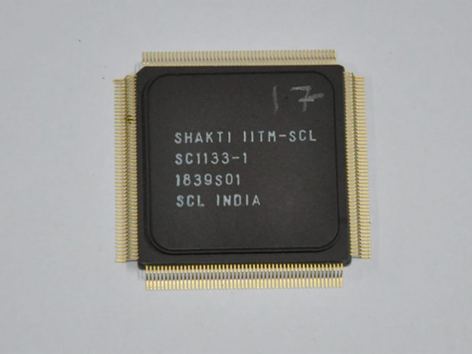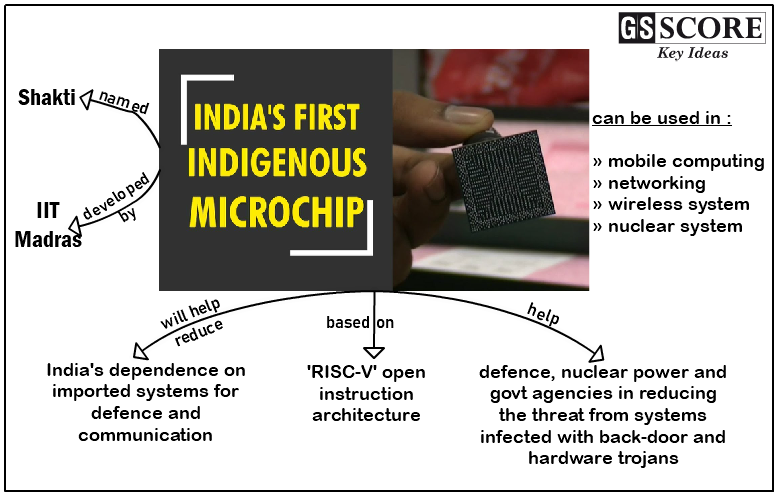

- Researchers at IIT-Madras have designed and demonstrated India’s first indigenously developed microprocessor that can be used in mobile computing, networking, wireless systems, and may be even for country’s nuclear systems.
- Named as ‘Shakti’, India’s first indigenous microprocessor is designed, developed and booted by Indian Institute of Technology Madras, with a microchip fabricated in the Semi-Conductor Laboratory of Indian Space Research Organisation (ISRO) at Chandigarh.
Context
- Researchers at IIT-Madras have designed and demonstrated India’s first indigenously developed microprocessor that can be used in mobile computing, networking, wireless systems, and may be even for country’s nuclear systems.
- Named as ‘Shakti’, India’s first indigenous microprocessor is designed, developed and booted by Indian Institute of Technology Madras, with a microchip fabricated in the Semi-Conductor Laboratory of Indian Space Research Organisation (ISRO) at Chandigarh.
About
- Launched in 2014, the Shakti project was aimed at developing industrial-grade microprocessors and other components of the microprocessor ecosystem. It is partly funded by the Ministry of Electronics and Information Technology (MeitY) as part of two-decade-old efforts to develop indigenous microprocessors.
- A team of about 30 designers, modified and chiselled over nearly a decade, have designed the Shakti processor at the Reconfigurable Intelligent Systems Engineering (RISE) Laboratory at the IIT-Madras’ department of computer science and engineering, to specifically work for the internet of things and small devices.
- According to Prof. Kamakoti Veezhinathan, lead researcher at IITM’s RISE laboratory, Shakti is based on the RISC-V (pronounced as risk-five), the design originated from an open source instruction set architecture, a set of basic instructions a processor understands, called RISC V, which makes it customisable to any device.
- RISC-V is based on a principle that allows the processor to execute instructions in fewer cycles than other instruction sets, and also provides for the development of modular processors and their extensions, enabling easy customisation. The compilers, debuggers, and operating systems that come with it are all open-source and modifiable. Shakti is the first ‘RISC V Microprocessor’ to be completely designed and made in India.
- The brain of all computing and electronic devices, many such microprocessors that are connected are used to operate larger high-speed systems and super computers.

Important Indian achievements in the field of microprocessor
- While “Shakti” is India’s first indigenously developed microprocessors, Indian engineers have long been counted among the pioneers in the field.
- Most prominent among them is Vinod Dham, who is known as the father of the Pentium microprocessor that reportedly made Intel the world’s biggest chip-maker. Ajay Bhatt, the inventor of the USB, is also credited with improving chipset configurations.
- Other pioneers include Ravishanker Kuppuswamy, who led the design team that built the Xeon E7 for Intel, and the duo — Gurindar Sohi and Terani Vijaykumar — who famously sued Apple for the infringement of a patent to make processors more efficient, and won.
Significance
- The processor Shakti, is said to be on a par with its international counterparts, and will eventually help reduce India’s dependence on imported systems and the risk of cyber-attacks making it ideal for communication and defence sectors.
- Apart from reducing the nation’s dependency on imported microchips, the chip will find uses in several applications in India, including in smartphones, surveillance cameras, smart meters as well as nuclear systems, according to a 2017 report by the Department of Atomic Energy.
- With the advent of Digital India there are several applications that require customisable processor cores. Shakti can be used for any application where conventional power is available.
- India’s first indigenous microprocessor has already attracted the attention of Indian industry, and IIT-M is in touch with more than 13 companies involved in strategic and commercial applications. The team is now ready with ‘Parashakti’, an advanced microprocessor for super computers. The super scaler processer will be ready by December 2018. It will go into desktops and 32 of them interconnected can go into supercomputers.
Learning Aid




